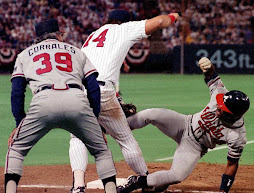Wednesday, March 31, 2010
Tuesday, March 30, 2010
James Gadson
From Wikipedia
James Gadson (born June 17, 1939) is an American drummer and session musician. Beginning his career in the late 1960s, Gadson has since become one of the most-recorded drummers in the history of R&B music.
Born in Kansas City, Missouri, Gadson played with the first line-up of Charles Wright's Watts 103rd Street Rhythm Band and recorded three albums with them between 1968 and 1970. Along with other members of Wright's band he went on to appear on many hit records including Dyke & the Blazers. Gadson started to become well-known as a drummer following the release of the album Still Bill, by Bill Withers, released by Columbia Records in 1972. In 1973 he played on the Temptations album Zoom, released on the Motown label in 1972. In 1975 he played with Freddie King on Larger than life and went on to record with Martha Reeves, Randy Crawford, Quincy Jones, Herbie Hancock, BB King, Albert King, Rose Royce, Elkie Brooks and many more household names.
He has a brief appearance in the Adam Sandler 2009 movie Funny People as a member of the jam band that Sandler's character hires to play with him.
In June, 2009, Gadson joined Beck, Wilco, Feist and Jamie Lidell covering Skip Spence's Oar as part of Beck's Record Club series, with videos appearing on Beck's website beginning November, 2009.He has previously drummed on Beck's albums Sea Change and The Information.
Watch the Drummer:
James Gadson (born June 17, 1939) is an American drummer and session musician. Beginning his career in the late 1960s, Gadson has since become one of the most-recorded drummers in the history of R&B music.
Born in Kansas City, Missouri, Gadson played with the first line-up of Charles Wright's Watts 103rd Street Rhythm Band and recorded three albums with them between 1968 and 1970. Along with other members of Wright's band he went on to appear on many hit records including Dyke & the Blazers. Gadson started to become well-known as a drummer following the release of the album Still Bill, by Bill Withers, released by Columbia Records in 1972. In 1973 he played on the Temptations album Zoom, released on the Motown label in 1972. In 1975 he played with Freddie King on Larger than life and went on to record with Martha Reeves, Randy Crawford, Quincy Jones, Herbie Hancock, BB King, Albert King, Rose Royce, Elkie Brooks and many more household names.
He has a brief appearance in the Adam Sandler 2009 movie Funny People as a member of the jam band that Sandler's character hires to play with him.
In June, 2009, Gadson joined Beck, Wilco, Feist and Jamie Lidell covering Skip Spence's Oar as part of Beck's Record Club series, with videos appearing on Beck's website beginning November, 2009.He has previously drummed on Beck's albums Sea Change and The Information.
Watch the Drummer:
Monday, March 29, 2010
Sunday, March 28, 2010
Science Daily
ScienceDaily (Mar. 27, 2010) — Long-term climate fluctuations were probably the main reason for the extinction of the dinosaurs and other creatures 65 million years ago. This conclusion was reached by PD Dr. Michael Prauss, paleontologist at Freie Universitaet Berlin, based on his latest research results.
Prauss thus challenges the almost 30-year-old theory that a meteorite impact at the Mexican Yucatan peninsula was the single cause for one of the five largest mass extinctions in Earth history, which has most recently been reiterated in a publication in the journal Science. According to Prauss, the impact was only one in a chain of catastrophic events that caused substantial environmental perturbations, probably largely controlled by the intermittent activity of the Deccan volcanism near the then-Indian continent, that continued over several million years and peaked at the Cretaceous-Paleogen boundary.
"The resulting chronic stress, to which of course the meteorite impact was a contributing factor, is likely to have been fundamental to the crisis in the biosphere and finally the mass extinction," says Michael Prauss. In a research project funded by the Deutsche Forschungsgemeinschaft (DFG, German Research Foundation) and in collaboration with Prof. Dr. Gerta Keller, paleontologist at Princeton University, U.S.A., Prauss analyzed several drill cores and rock sections covering the extended Cretaceous-Paleogene boundary interval at Brazos River, Texas, USA. The investigated region is located about 1000 km northwest of the Chicxulub impact crater and is well known among geologic scientists for its exceptionally complete preservation of Upper Cretaceous sediments.
Based on an analysis of the appearance and distribution of organic-walled microfossils such as Algal cysts, pollen, and spores of terrestrial plants, Prauss shows that significant and persistent variations in the ecosystem of the Upper Cretaceous started long before the meteorite impact. Among others, these are reflected by fluctuations in sea-level and marine algae productivity.
Prauss also considers it highly problematic to equate the meteorite impact with the position of the Cretaceous-Paleogene boundary: "The actual impact took place well before the geochemically and micropaleontologically defined Cretaceous Paleogene boundary." He supports his assertion with the position of the so-called fern spike, an episodic, significant increase in the proportion of fern spores caused by the pioneering phase of ferns in repopulating landscapes of destroyed ecosystems. In all sections of the investigated area the fern spike occurs well before important stratigraphic evidence for the Paleogene.
The new results contradict a publication by Schulte et al. (2010) in the March 5 issue of Science. Schulte et al. summarize the Cretaceous-Paleogene issue only to arrive at the 30-year-old theory of the impact as the sole cause of mass extinction. The occurrence of substantial fluctuations within the ecosystem of the Upper Cretaceous before the impact is disputed and the impact event is equated in time with the biostratigraphic Cretaceous-Paleogene boundary. "In the light of the new data, both of these points have to be refuted," says Prauss.
Take, Take, Take
I was sitting there in a comfortable chair
And that was all that I needed
Then my friend offered me a drink for us to share
And that was all that I needed
Well, then I felt at ease
But then I'm not too hard to please
I guess you couldn't call me greedy
Then I was shocked to look up
And see rita hayworth there in a place so seedy
She walked into the bar with her long, red, curly hair
And that was all that I needed
And I said to my friend, "good god, we're lucky men just to even see her"
Take, take, take
Take, take, take
Take, take, take
And I could not resist, I just had to get close to her
And that was all that I needed
I walked and loomed around her table for a while
And that was all that I needed
Then I said, "i hate to bug you, ma'am, but can I have your autograph?"
And that was all that I needed
She pressed her lips against a white piece of paper
And that was all that I needed
Then I saw what she wrote, my heart is in my mouth
And that was all that I needed
Then she handed it to me, and I think that she could see
That that was all that I needed
I started to walk away but then I remembered 'hey, I forgot to get a picture'
So I asked her one more time, "could I have another favor?"
That was all that I needed
She was kind and posed with me
Then I knew my friend would see my celebrity meeting
Take, take, take
Take, take, take
Take, take, take
She turned and said to me, "I need to go to sleep,"
And it seemed so mean
It's almost as if she could not appreciate how cool I was being
She said, "good night" and walked away
And I didn't know what to say
I just couldn't believe it
Well, it's just not fair
I want to get a piece of hair
That was all that I needed
Or maybe a kiss on the cheek
I wouldn't wash it for a week
That would be all that I needed
But she didn't even care
That I was even there
What a horrible feeling
Thursday, March 25, 2010
Wednesday, March 24, 2010
Say What?
You can spend minutes hours days even months analyzing a situation, trying to put the pieces together, justifying what could have should have would have happened...or you can leave the pieces on the floor and move the fuck on!- Tupac Amaru Shakur
Tuesday, March 23, 2010
Monday, March 22, 2010
Saturday, March 20, 2010
Barcode
ScienceDaily (Mar. 19, 2010) — Long lines at store checkouts could be history if a new technology created in part at Rice University comes to pass.
Rice researchers, in collaboration with a team led by Gyou-jin Cho at Sunchon National University in Korea, have come up with an inexpensive, printable transmitter that can be invisibly embedded in packaging. It would allow a customer to walk a cart full of groceries or other goods past a scanner on the way to the car; the scanner would read all items in the cart at once, total them up and charge the customer's account while adjusting the store's inventory.
More advanced versions could collect all the information about the contents of a store in an instant, letting a retailer know where every package is at any time.
The technology reported in the March issue of the journal IEEE Transactions on Electron Devices is based on a carbon-nanotube-infused ink for ink-jet printers first developed in the Rice lab of James Tour, the T.T. and W.F. Chao Chair in Chemistry as well as a professor of mechanical engineering and materials science and of computer science. The ink is used to make thin-film transistors, a key element in radio-frequency identification (RFID) tags that can be printed on paper or plastic.
"We are going to a society where RFID is a key player," said Cho, a professor of printed electronics engineering at Sunchon, who expects the technology to mature in five years. Cho and his team are developing the electronics as well as the roll-to-roll printing process that, he said, will bring the cost of printing the tags down to a penny apiece and make them ubiquitous.
RFID tags are almost everywhere already. The tiny electronic transmitters are used to identify and track products and farm animals. They're in passports, library books and devices that let drivers pass through tollbooths without digging for change.
The technology behind RFID goes back to the 1940s, when Léon Theremin, inventor of the self-named electronic music instrument heard in so many '50s science fiction and horror movies, came up with a spy tool for the Soviet Union that drew power from and retransmitted radio waves.
RFID itself came into being in the 1970s and has been widely adopted by the Department of Defense and industry to track shipping containers as they make their way around the world, among many other uses.
But RFID tags to date are largely silicon-based. Paper or plastic tags printed as part of a package would cut costs dramatically. Cho expects his roll-to-roll technique, which uses a gravure process rather than ink-jet printers, to replace the bar codes now festooned on just about everything you can buy.
Cho, Tour and their teams reported in the journal a three-step process to print one-bit tags, including the antenna, electrodes and dielectric layers, on plastic foil. Cho's lab is working on 16-bit tags that would hold a more practical amount of information and be printable on paper as well.
Cho came across Tour's inks while spending a sabbatical at Rice in 2005. "Professor Tour first recommended we use single-walled carbon nanotubes for printing thin-film transistors," Cho said.
Tour's lab continues to support the project in an advisory role and occasionally hosts Cho's students. Tour said Rice owns half of the patent, still pending, upon which all of the technology is based. "Gyou-jin has carried the brunt of this, and it's his sole project," Tour said. "We are advisers and we still send him the raw materials" -- the single-walled carbon nanotubes produced at Rice.
Printable RFIDs are practical because they're passive. The tags power up when hit by radio waves at the right frequency and return the information they contain. "If there's no power source, there's no lifetime limit. When they receive the RF signal, they emit," Tour said.
There are several hurdles to commercialization. First, the device must be reduced to the size of a bar code, about a third the size of the one reported in the paper, Tour said. Second, its range must increase.
"Right now, the emitter has to be pretty close to the tags, but it's getting farther all the time," he said. "The practical distance to have it ring up all the items in your shopping cart is a meter. But the ultimate would be to signal and get immediate response back from every item in your store -- what's on the shelves, their dates, everything.
"At 300 meters, you're set -- you have real-time information on every item in a warehouse. If something falls behind a shelf, you know about it. If a product is about to expire, you know to move it to the front -- or to the bargain bin."
Tour allayed concerns about the fate of nanotubes in packaging. "The amount of nanotubes in an RFID tag is probably less than a picogram. That means you can produce one trillion of them from a gram of nanotubes -- a miniscule amount. Our HiPco reactor produces a gram of nanotubes an hour, and that would be enough to handle every item in every Walmart.
"In fact, more nanotubes occur naturally in the environment, so it's not even fair to say the risk is minimal. It's infinitesimal."
Co-authors of the paper include Rice graduate student Ashley Leonard; Minhun Jung, Jinsoo Noh and Gwangyong Lee of Sunchon National University; and Jaeyoung Kim, Namsoo Lim, Chaemin Lim, Junseok Kim, Kyunghwan Jung and Hwiwon Kang of the Printed Electronics Research Center, Paru Corp., Sunchon, Korea.
Wednesday, March 17, 2010
Two Types of People In This World:
Those who jaywalk as soon as the coast is clear and those who wait for someone else to jaywalk. Fuck the latter group. Pussies
Tuesday, March 16, 2010
Sunday, March 14, 2010
Saturday, March 13, 2010
Reaction
This video contains cameos by Michael Jordan, Reggie Miller, Rik Smits, Scottie Pippen, Marc Jackson, Chris Mullin, Rick Carlisle, Toni Kukoc, Ron Harper and most memorably, Larry Bird.
Friday, March 12, 2010
Thursday, March 11, 2010
The NBA on Sacramento
from realgm.com:
One Sacramento fan was loud and persistent enough to draw reactions from Chris Bosh and Jarett Jack during Toronto's 113-90 loss to the Kings on Wednesday.
The fan yelled at Bosh, after a first-quarter timeout, to ask if he might sign with Sacramento.
"Hell no!" said Bosh in a disgusted reply.
The same fan continued his inquires into the third quarter, which eventually elicited a reply from Jack.
"Ain’t nobody coming here," Jack said. "Nobody even knows it’s in California."

Wednesday, March 10, 2010
Tuesday, March 9, 2010
Monday, March 8, 2010
Saturday, March 6, 2010
Wednesday, March 3, 2010
Tuesday, March 2, 2010
Monday, March 1, 2010
Zidane
from the associated press:
MADRID -- Former Real Madrid and France soccer star Zinedine Zidane says he regrets headbutting Marco Materazzi during the 2006 World Cup final, but he'd rather die than apologize to the Italian defender.Multicultural Friends are going on the record and banishing Marco Matterazi to the Hall of Shame, permanently. The guy is the epitome of what people should be trying not to be. Phony, weak, untalented, unable to admit to his mistakes and take accountability for them. All of it by choice.
In an interview with leading Spanish daily El Pais published Monday, Zidane recalled the infamous incident with a sense of shame -- but he felt none toward Materazzi.
"After the game, I went into the dressing room and told them, 'Forgive me. This doesn't change anything, but sorry everyone," Zidane recalled of the moments after the game.
"But to him I can't. Never, never," Zidane added. "It would be to dishonor me. ... I'd rather die."
The match was Zidane's last after a sparkling career in which he became one of the game's most respected players. In the 20th minute of extra time, Materazzi insulted Zidane, who responded by headbutting the Italian defender violently in the chest. He got sent off and watched France lose the match from the sideline.
"Of course I reproach myself," Zidane told El Pais. "But if I say 'Sorry,' I would also be admitting that what he did was normal. And for me it was not normal.
"Things happen on the pitch. It's happened to me many times. But I could not stand it that time," Zidane said. "My mother was sick. She was in hospital. This people didn't know. ... But it was a bad moment. More than once they had insulted my mother and I never responded."
Materazzi recently told Italy's La Republica paper he was still waiting for Zidane to apologize and that he was still so angry over the incident that he won't even watch this year's tournament in South Africa.
"If it was Kaka, an ordinary guy, a good guy, of course I would have apologized. But to this one!" Zidane said. "If I ask forgiveness of him, I lack respect for myself and for all those I love with all my heart."
Zidane won two Serie A titles with Italy's Juventus and two La Liga titles and a Champions League with Real Madrid, along with the 1998 World Cup. He was voted FIFA World Player of the Year three times.
Now 37, he acts as an informal adviser to Real Madrid president Florentino Perez.
Subscribe to:
Posts (Atom)















.jpg)












































